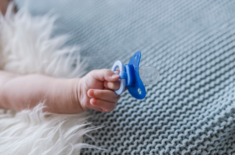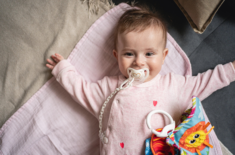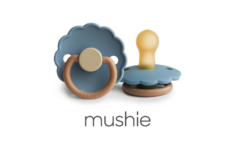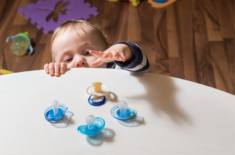Overview
The AAP (American Academy of Pediatrics) recommends pacifier use for babies up to six months of age to reduce the risk of SIDS (Sudden Infant Death Syndrome), the leading cause of death in infants under one year old. (1)(2)
Your baby’s pacifier (binky or paci) also soothes them while sleeping. If it helps reduce SIDS risks, then it makes sense to let your baby keep it overnight.
However, you might still have other questions like:
“Can newborns sleep with a pacifier?”
“Should I wait until my baby is a few weeks old before giving them a pacifier?”
“Will pacifier use interfere with breastfeeding and cause dental issues?”
“What items can I offer instead of a pacifier?”
“What are the risks of extended pacifier use?”
“When should I start weaning my baby?”
Let’s discuss the answers to these questions below.
Should I Remove The Pacifier After My Baby Sleeps?
No. Studies have shown that pacifier use can reduce the risk of SIDS in your baby’s sleep environment, although the exact mechanisms of why that happens remain unknown. (1)
Researchers theorize that pacifiers can protect babies from SIDS through the following possible mechanisms: (3)(4)
- Keeping the tongue forward (while sucking) to keep the upper airway unobstructed
- Providing a mechanical barrier from rolling over into the prone position
- Lowering your baby’s auditory arousal threshold (arousal from deep to light sleep or from sleep to being awake)
- Reducing gastroesophageal reflux and apnea (a potentially serious sleep disorder wherein breathing repeatedly stops and starts)
- Offering a soothing effect so your baby might not move as often during sleep (limiting their chance of becoming covered by blankets)
WARNING: Although the study mentions that pacifiers might reduce your baby’s risk of getting covered by blankets because they don’t move as much, the AAP doesn’t recommend putting blankets or other things in your baby’s sleep environment to avoid suffocation risks.
Can You Leave The Pacifier While Your Baby Sleeps?
Yes. There’s no reason why you should remove the pacifier from your sleeping baby unless you’re trying to wean them.
But if the pacifier falls off your baby’s mouth, you don’t have to return it.
Can Your Baby Sleep With A Pacifier All Night?
Yes. As long as your baby is within the AAP’s recommended age, there isn’t a set limit to how long they can use a pacifier while sleeping.
All pacifiers sold on the market must meet the minimum safety standards set by the pacifier regulation (16 CFR part 1511), plus additional requirements, such as the CPSIA (Consumer Product Safety Improvement Act of 2008). (5)
These are rated as safe for your baby to use.
However, always check for signs of damage or wear and tear.
Also, avoid using strings, cords, ribbons, or similar attachments to keep the pacifier in your baby’s mouth. These attachments can increase your baby’s risk of strangulation.
Why Do Pacifiers Make Sense At Night?
Although you might supervise your baby during short naps during the daytime, it’s certainly not a good idea to stay up and watch them throughout their night sleep.
Moms need to rest to help speed up your postpartum recovery.
Exhaustion and lack of sleep are among the most common factors that can affect your recovery. These might also lead to postpartum depression, anxiety, and other postpartum mood disorders or mental health concerns. (6)(7)
Giving your baby a pacifier is one of the easiest ways for them to sleep more soundly.
Because it could reduce the risks of SIDS, it also makes sense for your baby to use them at night for possible safe sleep and your peace of mind.
When Is It Okay To Introduce A Pacifier?
Breastfed Babies
Nipple confusion (when your baby experiences problems with breastfeeding after using a formula bottle or binky) might be one of the main reasons you’re unsure whether to give a pacifier to your little one.
If you’re breastfeeding, that’s a valid concern.
You can wait until breastfeeding is established and your baby no longer has trouble latching before giving them a pacifier. This usually happens around 3-4 weeks after birth. (8)
However, some babies (and moms) might take more than four weeks before they get the hang of breastfeeding. That’s alright, mama. You can wait until your baby is one month old and has mastered breastfeeding before giving them a binky.
Are Pacifiers Bad For Breastfeeding?
Studies about pacifier use and its effects on breastfeeding have conflicting results.
A 2013 study published in the AAP’s Pediatrics journal showed that pacifier restriction might actually decrease exclusive breastfeeding if access to baby formula isn’t restricted. (9)
Surprisingly, instead of an increase in exclusive breastfeeding, the restrictions on pacifier use could lead to increased exclusive formula feeding. (9)
Bottle-fed Babies
If you need or choose to feed your baby with infant formula, there’s no need to worry about nipple confusion.
You can offer a binky during sleep time, whether for short daytime naps or nighttime sleep.
Can Newborns Sleep With Pacifiers?
Yes. You might notice your newborn baby thumb sucking if you don’t give them a soother or pacifier. Some babies even begin doing this in the womb.
That’s because your newborn has natural rooting and sucking reflexes to help them find milk or soothe themselves to sleep.
Because it’s usually easier to wean a baby from a binky than a thumbsucking habit when the time comes, many moms prefer it as part of their baby’s bedtime routine.
When To Start Using A Pacifier If Your Baby Is Premature?
Some studies demonstrate that the use of a pacifier can help a premature baby transition more quickly from tube to oral feeding. These studies also show that listening to lullabies can speed up the process and encourage babies to develop their sucking reflexes. (10)
Still, it’s best to consult your pediatrician before giving a pacifier to your premature baby.
If you get a go-signal for pacifier use, you can pick one designed for preemies or newborn babies, but avoid those attached to a stuffed animal which can be a suffocation risk to these tiny infants.
Pros & Cons Of Pacifiers
What Are The Pros & Benefits Of Using A Pacifier?
Many parents have long turned to binkies to help their child sleep, especially during their first year of life.
Pacifiers could reduce the risk of Sudden Infant Death Syndrome, the leading cause of death in newborns and babies younger than a year old. (1)(2)
These binkies can also help babies soothe themselves and go back to sleep when they wake up in the middle of the night.
They also help establish baby sleep cycles and routines.
Other benefits of pacifier use:
- Satisfy your baby’s natural sucking reflexes
- Help soothe your fussy baby
- Promote weight gain and shorter hospital stays in preterm babies (10)
- Help premature babies transition more quickly from tube to oral feeding (10)
- Soothe colicky babies during sleep routines or at night
- Comfort your child during painful or stressful situations, including vaccine shots or other painful procedures (8)(11)
- Relieve painful pressure in the middle ear while riding an airplane
Many parents prefer giving their babies a pacifier instead of having them resort to thumbsucking, a habit that can be more difficult to break than simply tossing the binky away.
Pacifiers can also help soothe your baby during the 4-month sleep regression when their sleeping patterns change (this can make it more difficult for them to go back to sleep). This can be difficult for new parents to manage, especially if their baby keeps waking up and refusing to go back to sleep in the middle of the night.
If pacifier use doesn’t help, you can try other ways, such as:
- Playing lullabies
- Swaddling (until they start rolling over)
- Keeping the room dark
- Creating sleep associations (patterns or conditions your baby can associate with sleeping)
- Establishing a bedtime routine
- Asking for help from a sleep consultant
- Keeping nap times short during the day, especially during afternoons or close to bedtime
- Sleep training
What Are The Disadvantages & Risks Of Using A Pacifier?
Pacifier use can increase your baby’s risk for ear infections, particularly in younger children from six months to two years old. (12)(13)
Prolonged use of soothers and pacifiers can also increase the risk of dental problems in older babies, including crossbite, open bite, and other problems caused by misalignment of their teeth. (13)
The use of a pacifier might also interfere with breastfeeding, particularly due to nipple confusion. This can happen because even the most breast-like pacifier still differs from a mom’s natural nipples.
To avoid issues due to nipple confusion, it’s best to wait until breastfeeding is established before offering a binky to your baby.
It’s also possible for your baby to develop pacifier dependence, which can be a problem sometimes, especially if their pacifier falls off and they can’t find it. This could lead to crying spells in the middle of the night.
It’s very important to always check the pacifier before giving it to your baby to avoid choking hazards from damaged parts.
Even new pacifiers can still pose a choking risk due to possible design or manufacturing issues.
For example, FRIGG silicone pacifiers were recalled (also known as Mushie pacifiers) in January 2022 due to a design issue that might cause the nipples to detach from the plastic shield. (14)
Pacifier Safety Tips
- Always check the product packaging for the materials used in making the pacifier. Avoid anything with toxic chemicals such as BPA (bisphenol-A and phthalates).
- Monitor product safety alerts and recalls.
- Use the right size for your child’s age to avoid choking or breathing obstruction risks.
- DON’T attach a cord or string to the pacifier because that can be a strangulation risk.
- Keep the pacifier clean and regularly disinfect with hot water or use a sterilizer (check the manufacturer’s instructions on sterilizing the product).
- DON’T coat the pacifier with anything, particularly honey or sugar. Honey can contain bacteria that might cause a toxic condition called infant botulism in babies less than a year old, while sugar can cause tooth decay and increase your baby’s risk of obesity. (15)
- Only use one-piece pacifiers to avoid choking risks if the product breaks apart.
- Choose a pacifier with breathing holes in the guard.
How Many Hours Should My Baby Use A Pacifier?
There aren’t any guidelines or specific limits to how many hours your little one should use a pacifier.
However, the AAP recommends weaning your baby from binkies starting when they’re six months of age to help reduce ear infection risks. (16)
Do You Need To Wean Your Baby Off The Pacifier?
Yes. Prolonged pacifier use can increase the risk of ear infections and dental problems in older babies, particularly those over four years old. (12)(13)
When Should You Take The Pacifier Away At Night?
If possible, you can start weaning your baby when they’re six months old. (16)
Ways To Stop Pacifier Use
Cut Down Pacifier Use During The Day
Gradually reduce pacifier use by not offering it to your baby during daytime naps. You can soothe them to sleep with a lullaby, singing songs, or other distractions to make them forget their beloved paci.
The Pull-Out Method: How Do I Get Rid Of The Pacifier At Night?
Don’t take your baby’s pacifier in the middle of the night if they’re used to sucking on it overnight. They might get confused and cry if they sleep with one and can’t find it when they wake up.
Some moms try the pull-out method by getting the pacifier when the sucking slows down (but before the baby falls asleep). This can be tricky and requires patience until your baby learns to self-soothe without a pacifier.
Go Cold Turkey
Many moms find the cold turkey method to be the most effective, especially when done while you train your baby for self-soothing.
The cold turkey method is easy: just stop giving a pacifier to your baby and hide or throw it away so they can’t see it anymore. They might cry as they try to find their pacifier during bedtime, but they can find other self-soothing methods and soon forget about the binky after a few days.
Although it can be distressing to see your baby crying, many moms agree that this can be one of the fastest ways to wean your baby from a pacifier.
How Do I Stop My Little One From Crying Without A Pacifier?
Try to find the main reason why your baby is crying:
- Hungry
- Needs a diaper change
- Tummy ache from constipation, bloating, colic, or other problems
- Fever or colds
If they’re still fussy, you can try other ways to soothe them:
- Rocking
- Cuddling
- Singing
- Picking them up
How Do I Teach My Baby To Self-Soothe Without A Pacifier?
Your baby needs to learn to self-soothe so they won’t always rely on a pacifier, especially if they’re older than six months.
Here are some tips for doing it:
- Create a dark, cool, and quiet sleep environment in their nursery
- Establish a bedtime routine and give your baby sleep cues, such as taking a bath or reading a book
- Begin sleep training and be consistent. As sweet and tempting as it can be to cradle your baby to sleep, it can confuse them when they wake up in a different environment (their crib) in the middle of the night. So, try to train them to sleep on their own inside their crib.
- You might consider moving their feeding schedule further away from bedtime, such as an hour early.
- Encourage them to sleep with soothing words or an occasional back rub.
What Can I Use Instead Of A Pacifier?
You can offer a security object (such as a lovey or stuffed toy and a small, soft blanket) if your child is old enough to have one without suffocation risks, usually when they’re at least a year old.
How Long Does Pacifier Withdrawal Last?
It can vary. Pacifier-dependent babies are likely to take longer than others to get used to having no binky at all.
However, many parents notice that it usually takes around 3-5 days before their baby gets used to the new situation.
Asking Your Pediatrician
Consult your pediatrician before introducing a pacifier to a premature baby.
Other Pacifier & Sleep FAQs
Why Do Babies Like Using A Pacifier?
Babies are born with rooting and sucking reflexes. These help them find milk and soothe themselves to sleep. So, they’re also naturally inclined to like pacifiers.
Are Pacifiers Important?
It’s estimated that as many as 75% of babies in Western countries are offered a pacifier at some time. They’re popularly used for soothing babies and helping them fall asleep. (8)
However, because they’re also linked to possible dental problems, pacifiers are a subject of a long-standing debate (whether they should or shouldn’t be given to babies).
Do Pacifiers Cause Gas?
They’re not usually considered a major culprit in causing colic or gas, but pacifiers can also cause babies to swallow excessive air. (17)
How To Clean Pacifiers?
Use soap and water to clean your baby’s pacifier by hand, in the same way that you sanitize their bottles.
You can also opt to put the pacifier in the dishwasher and sterilizer (check the packaging if it’s safe to do this for the product you picked).
What Other Ways Can Help Lower The Risk Of SIDS?
- Keep your baby’s safe sleep environment free from loose blankets, pillows, crib bumpers, loveys or stuffed toys, and other items that might cause suffocation.
- Choose a firm, flat mattress. If possible, choose a breathable crib mattress.
- Avoid putting strings or cords on your baby’s pacifier.
- Avoid putting your baby to sleep in products that don’t have a flat, unobstructed surface, such as inclined sleepers, infant rockers, swings, baby carriers, car seats, baby loungers, etc.
The Best Pacifier For Newborns & Breastfed Babies
Some of the top pacifiers for breastfed babies:
- Nanobebe Baby Flexy Pacifier
- Itzy Ritzy Sweetie Soother
- TOMY Boon JEWL Orthodontic Silicone Pacifier
- Ryan & Rose Cutie Pat (Slant) 2-in-1 Pacifier and Teether
- Chicco PhysioForma mi-cro Orthodontic Pacifier
- Philips Avent Ultra Air Nighttime Pacifier
- Tommee Tippee Closer to Nature Breast-Like Pacifier
- Dr. Brown’s HappyPaci Pacifier with Lovey Soft Toy Holder
- Wubbanub Pacifier
- Doddle & Co. The Pop Silicone Pacifier
- Nuk Airflow Pacifier
- MAM Perfect Pacifier
REFERENCES
(1) https://www.hopkinsmedicine.org/health/conditions-and-diseases/breastfeeding-your-baby/breast-feeding-getting-started
(2) https://kidshealth.org/en/parents/sids.html
(3) https://www.ncbi.nlm.nih.gov/pmc/articles/PMC2791559/
(4) https://pubmed.ncbi.nlm.nih.gov/10839876/
(5) https://www.cpsc.gov/Business–Manufacturing/Business-Education/Business-Guidance/Pacifiers-Business-Guidance
(6) https://pubmed.ncbi.nlm.nih.gov/26382160/
(7) https://www.ncbi.nlm.nih.gov/pmc/articles/PMC7082815/
(8) https://onlinelibrary.wiley.com/doi/full/10.1111/jpc.12402
(9) https://publications.aap.org/pediatrics/article-abstract/131/4/e1101/31885/Pacifier-Restriction-and-Exclusive-Breastfeeding?redirectedFrom=fulltext
(10) https://pubmed.ncbi.nlm.nih.gov/21668549/
(11) https://www.ncbi.nlm.nih.gov/pmc/articles/PMC3001531/
(12) https://myhealth.alberta.ca/Health/Pages/conditions.aspx?hwid=ta1927
(13) https://www.semanticscholar.org/paper/Risks-and-benefits-of-pacifiers.-Sexton-Natale/69322d9364e457bb84c844579df6de7758183da8/figure/0
(14) https://www.cpsc.gov/Recalls/2022/Mushie-and-Co-Recalls-FRIGG-Silicone-Pacifiers-Due-to-Choking-Hazard
(15) https://www.nhs.uk/conditions/baby/weaning-and-feeding/foods-to-avoid-giving-babies-and-young-children/
(16) https://bmcpregnancychildbirth.biomedcentral.com/articles/10.1186/s12884-017-1306-8
(17) https://journals.lww.com/jpgn/Fulltext/2020/01000/Novel_Use_of_Impedance_Technology_Shows_That.26.aspx











